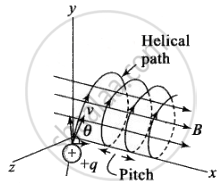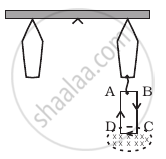Advertisements
Advertisements
प्रश्न
Two charged particles traverse identical helical paths in a completely opposite sense in a uniform magnetic field B = B0k̂.
विकल्प
They have equal z-components of momenta.
They must have equal charges.
They necessarily represent a particle-antiparticle pair.
The charge to mass ratio satisfy : `(e/m)_1 + (e/m)_2 = 0`.
उत्तर
The charge to mass ratio satisfy : `(e/m)_1 + (e/m)_2 = 0`.
Explanation:
In this situation, if the particle is thrown in x - y plane (as shown in figure) at some angle θ with velocity v, then we have to resolve the velocity of the particle in rectangular components, such that one component is along the field (v cosθ) and another one is perpendicular to the field (v sinθ). We find that the particle moves with constant velocity v cosθ along the field. The distance covered by the particle along the magnetic field is called pitch.
The pitch of the helix, (i.e., linear distance travelled in one rotation) will be given by
`p = T(v cos theta) = 2p m/(qB) (v cos theta)`
For given pitch p correspond to charge particle, we ahve
`q/m = (2pi v cos theta)/(qB)` = constant

Here in this case, charged particles traverse identical helical paths in a completely opposite sense in a uniform magnetic field B, LHS for two particles should be the same and of opposite sign. Therefore, `(e/m)_1 + (e/m)_2 = 0`
APPEARS IN
संबंधित प्रश्न
The free electrons in a conducting wire are in constant thermal motion. If such a wire, carrying no current, is placed in a magnetic field, is there a magnetic force on each free electron? Is there a magnetic force on the wire?
A charged particle is moved along a magnetic field line. The magnetic force on the particle is
State whether the following statement is true or false:
Magnetic poles exist in pairs.
Show that currents in two long, straight, parallel wires exert forces on each other. Derive the expression for the force per unit length on each conductor.
An electron travelling west to east enters a chamber having a uniform electrostatic field in north to south direction. Specify the direction in which a uniform magnetic field should be set up to prevent the electron from deflecting from its straight line path.
Correct unit of magnetic field is ______.
Which one of the following is a correct statement about magnetic forces?
In the product
`overset(->)("F") = "q"(overset(->)(υ) xx overset(->)("B"))`
= `"q"overset(->)(υ) xx ("B"overset(^)("i") + "B" overset(^)("j") + "B"_0overset(^)("k"))`
For q = 1 and `overset(->)(υ) = 2overset(^)("i") + 4overset(^)("j") + 6overset(^)("k")` and
`overset(->)("F") = 4overset(^)("i") - 20overset(^)("j") + 12overset(^)("k")`
What will be the complete expression for `overset(->)("B")`?
Show that a force that does no work must be a velocity dependent force.
A 100 turn rectangular coil ABCD (in XY plane) is hung from one arm of a balance (Figure). A mass 500 g is added to the other arm to balance the weight of the coil. A current 4.9 A passes through the coil and a constant magnetic field of 0.2 T acting inward (in xz plane) is switched on such that only arm CD of length 1 cm lies in the field. How much additional mass ‘m’ must be added to regain the balance?

